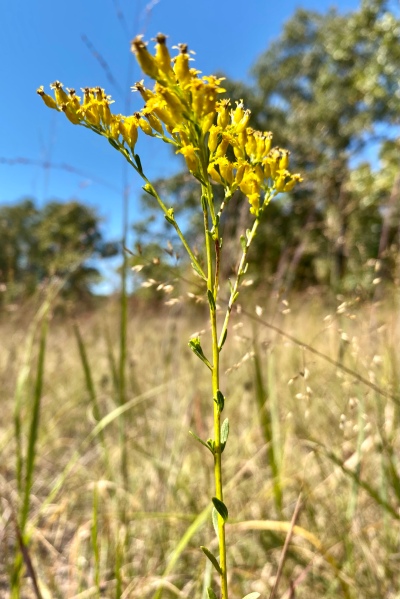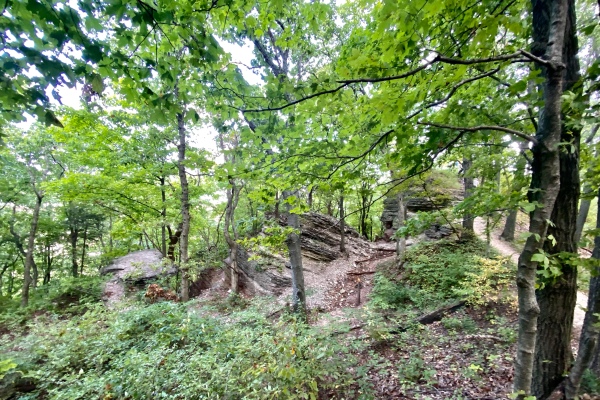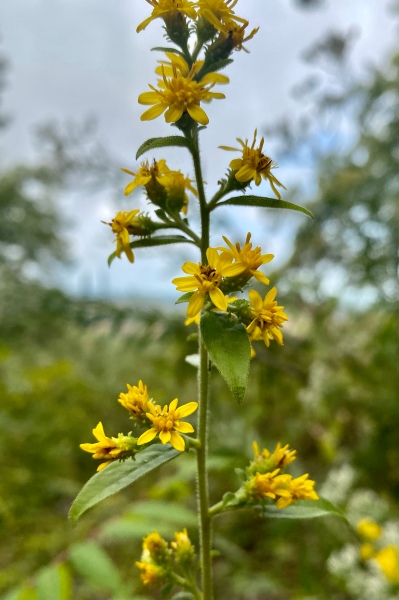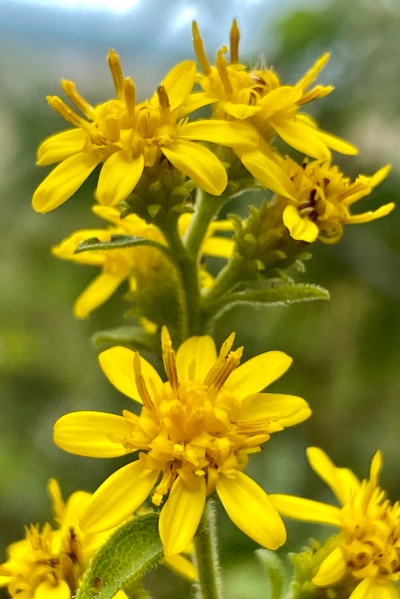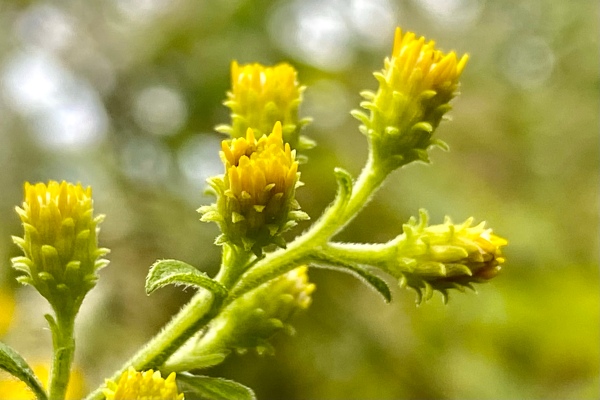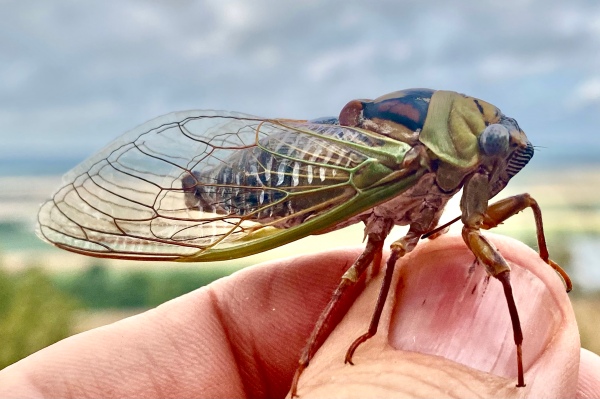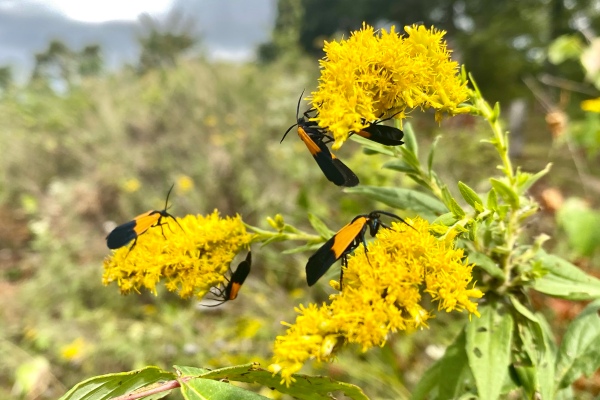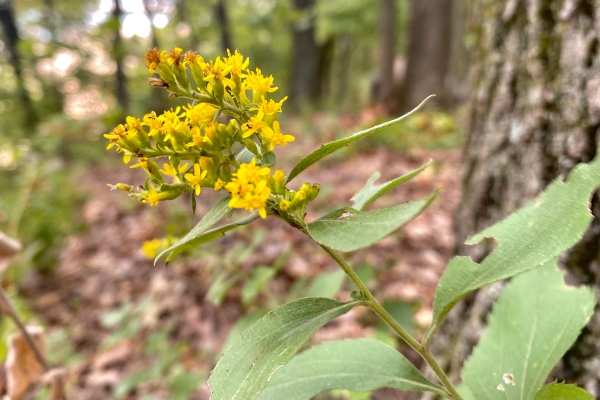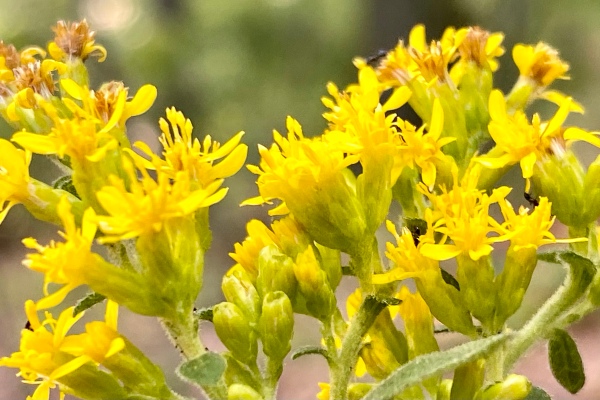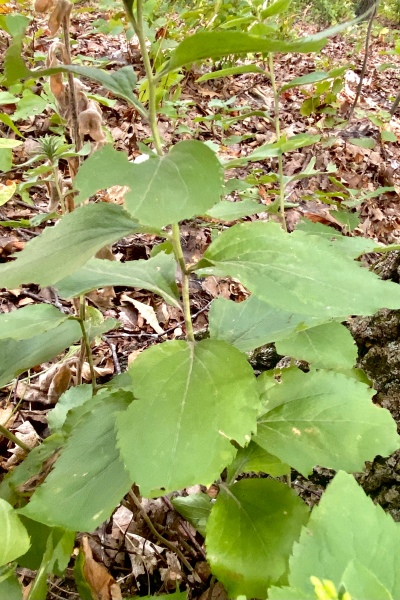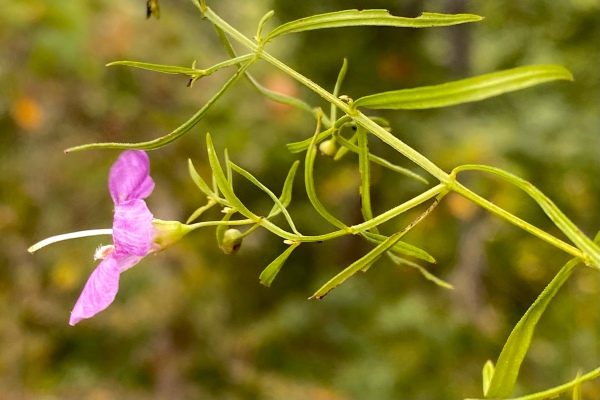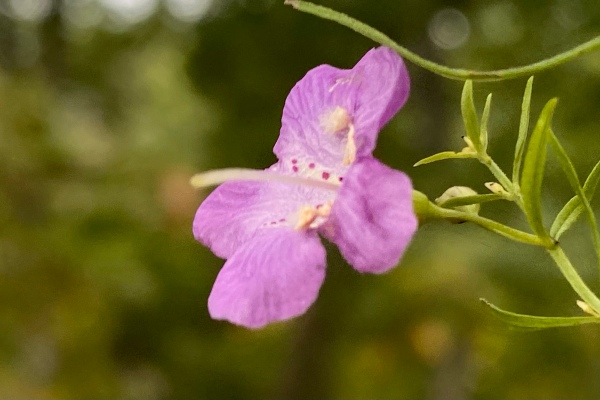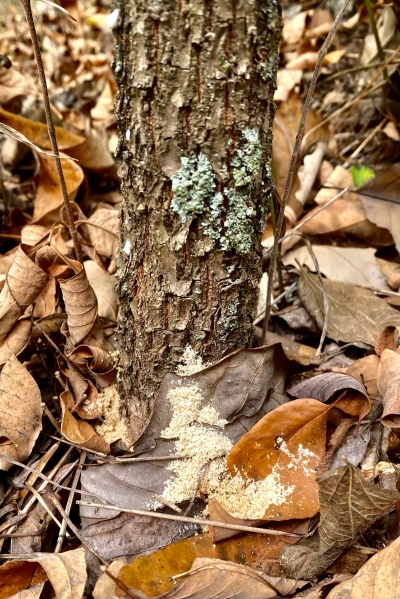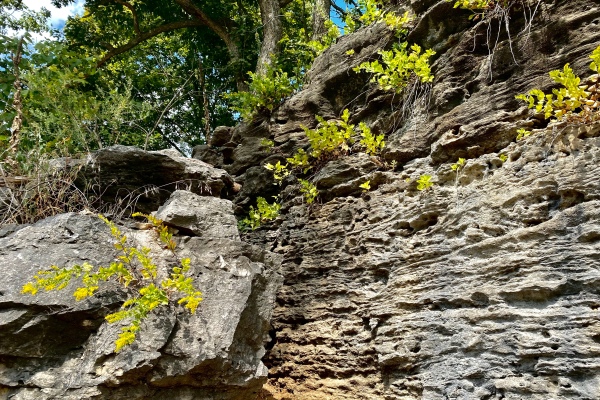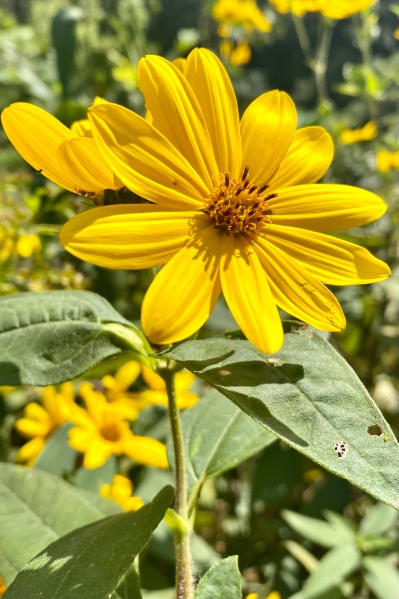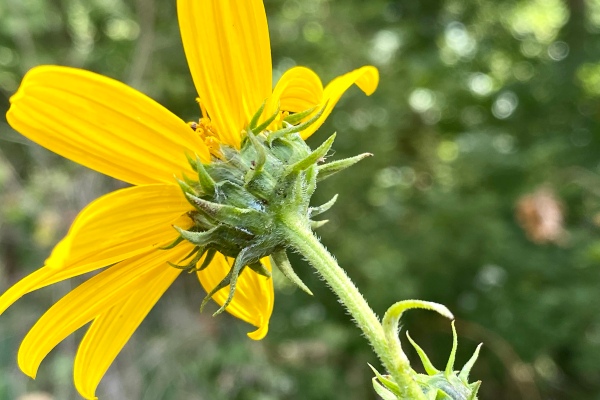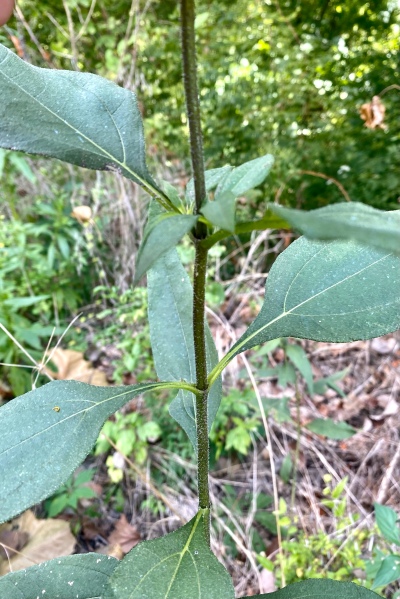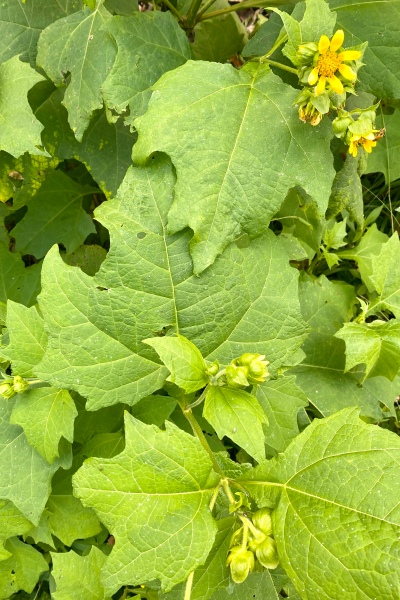By pure coincidence, the WGNSS Botany Group decided to visit Victoria Glades for today’s weekly field trip—just one day after I’d made my own solo visit, so for me a bonus visit! You might think that would result in me seeing the same things that I’d already seen, but unlike yesterday’s solo outing, I had the benefit of multiple pairs of eyes and solid botanical expertise accompanying me and directing my attention to several new-to-me plants.
A clump of sunflowers (Helianthus sp.) caught our attention even before we left the parking lot. Our initial impression was Jerusalem artichoke (H. tuberosus), but it lacked the alternate uppermost leaves usually found in that species. Nevertheless, when we ran it through the key and came to a choice between this species or woodland sunflower (H. hirsutus), we decided that it must be H. tuberosus. As we walked by another clump of the plants, we noticed the first insect of the day—a still-bedded-down helmeted squash bug (Euthochtha galeator), a type of leaffooted bug (family Coreidae)—on one of the older flower heads.

On the glade proper (MDC “west” side), the group was just as excited to immediately see the Great Plains ladies’-tresses orchids (Spiranthes magnicamporum) in bloom as I was yesterday, and I couldn’t resist the urge to take just a few more photos of two of impressively flowering specimens. We also noted the now brilliant red flowering dogwoods (Cornus florida) that anchored the small woody hammocks dotting the glade and were surprised to find a total of eight “tree” species taking refuge in the hammocks, the others being Carolina buckthorn (Rhamnus caroliniana), deciduous holly (Ilex decidua), eastern red-cedar (Juniperus virginiana), dwarf hackberry (Celtis tenuifolia), sugar maple (Acer saccharum), gum bumelia (Sideroxylon lanuginosum), and persimmon (Diospyros virginiana).

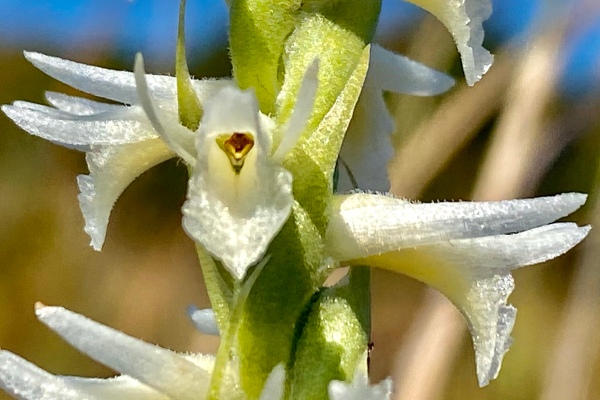
We made our way to the interface between the glade proper and a large dry post oak woodland hammock, where prairie gentian (Gentiana puberulenta) was found last year. As we walked, we got into a discussion about the pronunciation of the species name for Solidago gattingeri (Gattinger’s goldenrod). While “guh-TIN-jur-eye” may follow general guidelines for pronouncing latinized names, these guidelines do not apply to patronyms—i.e., scientific names derived from the name of a person, and for which the pronunciation of the person’s name is conserved in its latinized form. Since S. gattingeri was named after the German-born botanist Augustin Gattinger (pronounced “GAH-ting-er”) (1825–1903), the latinized form, which has an “i” added to the end of the name, and is thus pronounced “GAH-ting-er-eye.
Reaching the interface and searching for the gentian would prove fruitless, but it was not without its consolations. The first of these was one of the blue asters, which we eventually determined to be azure aster (Symphyotrichum oolentangiense)—distinguished by its rough leaves with the basal ones arrowhead-shaped. This species sparked a further conversation about how to pronounce the double-o at the beginning of the name. In latinized nomenclature, all vowels must be pronounced (except the diphthongs ae and oe, both of which are pronounced “ee”). The specific epithet derives from the Olentangy River in Ohio, but the person who named the species misspelled it, adding an extra “o” at the beginning. Unfortunately, the rules of nomenclature demand that original spellings, even those considered misspellings, be conserved (unless certain special conditions are met), thus, the specific epithet must begin with a double-o, and both of them must be pronounced. Further, since it is derived from a place name, the pronunciation of “Olentangy” also must be preserved. As a result, the species name is pronounced “oh-OH-len-TAN-jee-in-see.”



As we continued searching the glade-woodland interface, we encountered a healthy little patch of rough goldenrod (Solidago radula). Only a few of the plants bore inflorescences in good condition, but the plants were nevertheless recognizable by their small size and numerous rigid, scabrous, serrate leaves. We were pleasantly surprised to find this fairly conservative species (CC = 6), and everybody agreed that the species name is pronounced “RAD-yew-luh.”



When we reached the area where we were certain we should find prairie gentian, we instead found silky aster (Symphyotrichum sericeum)—their silvery leaves glistening in the sun and branchy stems mostly devoid of lower leaves making them visible and recognizable even from afar. This highly conservative species (CC = 9) is restricted to only a handful of states in the upper Midwest.



Once satisfied that we’d done our due diligence in our search for prairie gentian, we headed towards the top of the knoll where stiff sunflower (Helianthus pauciflorus) and rough white lettuce (Nabalus asper) have been observed in recent years. The sunflowers were found easily, though all in the apparently expanding patch were past bloom, but it took careful searching and reference to a GPS reading to find what amounted to just two, post-bloom white lettuce individuals. This latter species has a distribution centered roughly across Missouri and Iowa and is fairly conservative (CC = 7).

As we headed back towards the parking lot, we passed through a peninsula of dry post oak woodland, giving us the opportunity to see yet another blue aster, this one being prairie aster (Symphyotrichum turbinellum). This is another fairly conservative species (CC = 6) whose distribution centers over Missouri and extends to only a few surrounding states. The elliptic leaves, branched habit, and “vase-shaped” involucre were all clues to its identity.



By then, only John and Kathy remained and were ready to call it a day, but I had a hankering to visit the TNC “east” side to check the ninebarks (Physocarpus olulifolius intermedius) that grow along the toeslopes at the interface between the glade proper and the riparian woodland below to look for Dicerca pugionata—a spectacular jewel beetle (family Buprestidae) that breeds in the plant’s woody branches. This beetle is rarely encountered throughout most of its range across the eastern U.S. but seems to be common at this location—perhaps due to the general unthriftiness of the plants growing along the toeslopes, a drier than preferred situation that may compromise their ability to fend off colonization by the beetle. The beetles can be reliably found in spring and fall by examining the stems and leaves. As I searched for the beetles, I encountered “blue aster #4” on the day—aromatic aster (Symphyotrichum oblongifolium). In the case of this species, the reflexed phyllaries, branched habit, and oblanceolate sessile leaves absent at the base were the first clues to its identity. Crushing one of the leaves and smelling its fragrance left no further doubt.



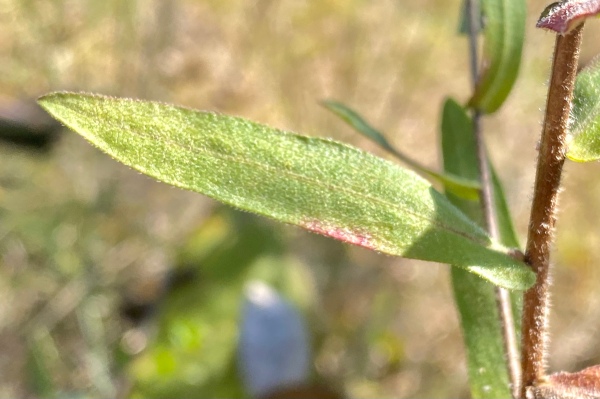
Continuing my search for the beetles, I noticed a garden spider (Argiope sp.) in its web. Something about it did not look right for the species we normally see in Missouri—the black-and-yellow garden spider (A. aurantia), and I eventually determined it to be instead a subadult male banded garden spider (A. trifasciata). The webs of this species tend to be more hidden than those of A. aurantia, and the preferred habitat is said to be drier, which may explain why this species tends not to be seen very often compared to its more commonly encountered cousin.

Eventually, I found two D. pugionata individuals perched on the outer twigs and leaves of ninebark—just as I expected, and I took comfort knowing that this rarely encountered species continues to thrive in this unique location.

Remarkably, I would encounter one more “blue aster,” finding spreading aster (Symphyotrichum patens) as I searched around and through the dry post oak woodland at the top of the slope in hopes that I might still find prairie gentian. This species, found in Missouri only south of the Missouri River, is easy to identify (even by entomologists) by virtue of its purple ray flowers with yellow disks and strongly clasping stem leaves with distinctive rounded basal auricles.
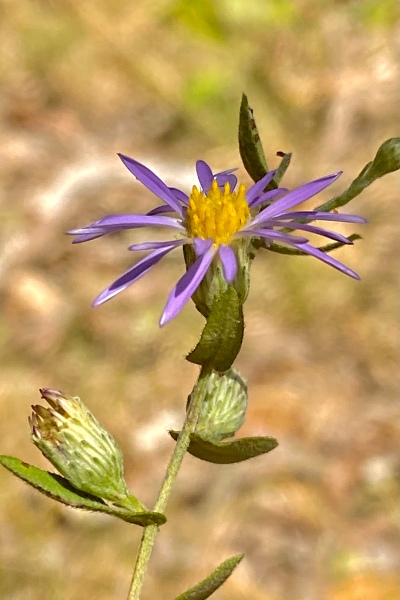


Five “blue asters” on the day, however, was enough to make this entomologist’s head spin, and with five hours in the field on a spectacular fall day, I finally headed back to the parking lot to close out the day.
©️ Ted C. MacRae 2021

